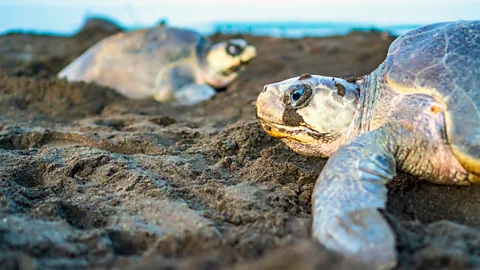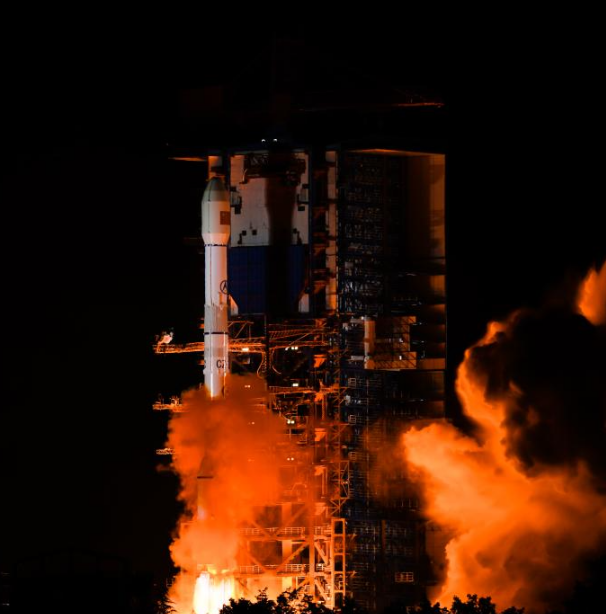07
2024-10
How satellites are mapping the future of turtle conservation
Marine turtles spend almost their entire lives at sea – but little is known about the paths they take. Now, satellites are helping scientists map their movements during the "lost years".
In early June 2024, Donna Shello, an adult female leatherback turtle, was hanging out on a sandy beach along the Caribbean coast of Panama. After laying about 80 eggs, and with a satellite transmitter attached to her back, she was ready to start competing in the Tour de Turtles, an intense oceanic "marathon" organised by the Sea Turtle Conservancy (STC), a US non-profit. This year, she is up against seven other leatherback females, and the winner will be the one who swims the longest distance.
"[Donna Shello] is at least 20 years old, but may be as old as 80 to 90," says Daniel Evans, a research biologist working at the STC. "There is currently no way to age a live sea turtle."
Although the "competition" only lasts three months, a full migration from nesting season to the next nesting season could take two years. From what they know so far, she has been laying between 70 and 90 eggs each time she nests, and could be nesting between four and seven times in a nesting season. "Based on three nesting seasons, she could have laid between 840 and 1,890 eggs since we first encountered her nesting in 2020," says Evans.
The STC has been tracking sea turtles for more than 20 years, monitoring their movements and migration patterns. Last year, a loggerhead turtle ventured further north than they had ever tracked before.
"Turtles are now going places that they didn't commonly go to," says Evans. "We are seeing them expand their range, exploring new areas that they either weren't able to before or didn't have a preference for."
Leatherback turtles can live for 100 years and spend much of there lives travelling the seas alone (Credit: Tom Doyle)
Most species of sea turtles are temperature sensitive, so the areas of the ocean they can travel to are limited. "These [loggerhead] adults going that far north is an indicator that the temperature of those waters has increased and are now more comfortable for these turtles to survive in," Evans adds.
Turtles also are also important biological transporters – carrying marine nutrients to land, leaving nutrients after nesting. They and their eggs are also important sources of food for other animals.
Sea turtles face multiple dangers across different life stages and habitats and, although they spend most of their lives in the water, there are still vast knowledge gaps about this part of their life. A 2021 study found only approximately 20% of research papers explored climate impacts on sea turtles in the ocean, and less than 5% were about turtles' distribution at sea.
Researchers Mariana Fuente and Simona Ceriani hold green turtles after attaching satellite tags to their backs (Credit: Florida State University)
Mariana Fuentes, marine conservation biologist and associate professor at Florida State University, has been studying sea turtles' behaviour in the ocean to identify some of those threats and is using scientific evidence to inform the design of marine protected areas (MPAs).
"I think satellite telemetry has been one of the tools that has helped most with conservation of sea turtles," Fuentes says.
Using satellites to track individual turtles has already aided scientists in identifying important hotspots like foraging areas, migratory corridors and breeding areas – as well as understanding their spatial distribution. Combining this information with data such as sea surface temperature, fisheries and boat activity and concentration of chlorophyll – an indicator for the amount of phytoplankton present in the ocean which has been seen to influence nesting – has been crucial for conservation work. "It gives you information on turtles' movements, and then you can couple that with other data to maximise information on exposure to stressors," says Fuentes.
For example, in a 2018 project, Fuentes and other authors identified areas of high use by threatened juvenile green turtles in the waters surrounding Bimini, Bahamas, habitats which were being severely degraded by coastal development. They divided their area of study into one square kilometre (0.4 sq miles) grid cells, and populated them with information about turtle density and local stakeholder use, among others. This allowed them to prioritise areas of high conservation value for the turtles and their prey, while also recommending consideration of the impact to the local community, costs and other socioeconomic factors.
And this is information researchers would not be able to obtain if it wasn't for these electronic devices. Many trackers are controlled by a microprocessor programmed by a computer before it is attached. Information is sent to polar orbiting satellites, which then feeds back to the researchers. "That's why satellite trackers are great, because you don't have to retrieve them and we can just sit with our computers and look at where turtles are," adds Fuentes.
She believes that with climate change, there might be shifts in the distribution of sea turtles, as their habitat and food availability is affected. In her recent paper, Fuentes describes climate change as a threat multiplier, as it interacts with and intensifies almost all other stressors sea turtles face.
Graeme Hays, a marine ecologist at Deakin University, Australia, has been following turtles via satellites for about 35 years and has witnessed the evolution of the technology.
"One of the really big things in the last decade is how much better satellite tracking has become. Devices are more and more robust and reliable, and people have now figured out really good ways of keeping tags attached," Hays says. "There's been a huge increase in the amount of data that can potentially be used to help drive the conservation of sea turtles."
And some of satellite data has already been used in that way. A 2016 study outlines 12 examples around the world, including species recovery policies, the strengthening of a marine park zoning, regulations restricting use of vertical panels of fishnets – or gillnets – to night-time when turtles are resting and an agreement between four countries to create and protect a corridor in the Pacific Ocean.
More recently, researchers compiled one of the world's largest single-species satellite tracking datasets, specifically for flatback turtles, endemic to northern Australia and classified as vulnerable in the country's Environment Protection and Biodiversity Conservation Act. The authors created detailed flatback distribution maps and identified areas where protective measures would benefit multiple populations at once. Importantly, they also found that flatbacks spent 99.5% of their time in Australian waters, making this a unique opportunity to conserve a marine turtle species through national and regional conservation measures.
However, other species, like Donna Shello, are global travellers. According to Hays, the number of leatherbacks is declining in many places because they are wandering all over the oceans chasing jellyfish, which may also be moving further afield due to climate change.
"If there was an Olympic gold medal for which marine species swims the most every year, I'd be surprised if the leatherback turtle wasn't the gold medal winner," says Hays. This elusiveness makes them harder to protect, as they spend much of their time in international waters, where there is no regulation. Approximately 3% of the global ocean is protected in marine-protected areas, but this can only happen in areas countries have control over. Exclusive economic zones (EEZs), where a nation has jurisdiction, only extend 200 nautical miles (370km) from their coasts.
"The big problem is that the vast majority of our ocean is no man's land," says Christine Figgener, marine biologist and founder of non-profit, Costa Rican Alliance for Sea Turtle Conservation and Science. "After the EEZs, it's the Wild West."
Around two-thirds of the Earth's oceans lie beyond national boundaries, also referred to as the "high seas". Last year, after nearly 20 years of negotiations, more than 80 countries signed an international treaty which provides a legal framework for addressing various stressors affecting the marine environment in the high seas, meaning that in the future, there might be protected areas in international waters. Figgener finds hope in this development, and that the use of data that she and others have collected about turtles' movements and behaviours could help in their conservation.
An extremely sticky epoxy resin is used to attach the transmitters… Some colleagues have even accidentally stuck themselves to a turtle – Christine Figgener
In her recent book My Life with Sea Turtles, Figgener elaborates on her work and experiences finding and capturing turtles at sea, and the challenges of carefully attaching transmitters on them. Figgener describes an occasion when she and her assistants were on a boat off Costa Rica's Pacific coast waiting patiently to see if a sea turtle came up for air. When a pair of olive ridley turtles finally appeared, Figgener and her assistant dove right in, wrestling underwater with the female who was trying to avoid being captured. When they got close enough to the boat, the two assistants lifted the 45kg (99lb) turtle in and covered her eyes with a dark, damp cloth to help reduce her stress.
Back on land, and despite bleeding from scratches on her legs, Figgener and the two assistants proceeded to restrain the turtle, clean the surface of the carapace – its upper shell – and prepare an extremely sticky epoxy resin that is used to attach the transmitter. They only have a few minutes to mould it because once it dries it's almost impossible to remove. She writes that it frequently sticks to her clothes, hair, nails, equipment… And some colleagues have even accidentally stuck themselves to a turtle. The ordeal then continued as they attached the transmitter, waited for it to harden and eventually released the turtle into more or less the area where they found her.
 (Credit: Getty Images)
(Credit: Getty Images)
Throughout her memoir, Figgener describes her years studying turtles in the field, witnessing how human activity, extreme weather and plastic affect them. However, from her book it is also clear that we still don't know enough.
"We really need to do a lot more on the side of migrations, because in most cases – for adults at least – they have very distinct foraging and nesting areas, and they are travelling between those back and forth," Figgener says. "How did the turtle get from Costa Rica to Canada? Nobody would know unless we used satellite transmitters. So it's really filling in the blanks."
Back in the race, Donna Shello is firmly in the lead, having already travelled 5,574km (3,464 miles). The latest information on her personalised map shows her foraging near New Jersey, United States.
In the coming months, Donna Shello might stay within the North Atlantic, or she could cross the Atlantic to the Azores and the coast of Western Europe. For turtles like her, conservation remains a challenge.
And – despite increasing numbers in some turtle populations – Hays warns: "It's no time for complacency. There are still huge threats and uncertainties about where [turtles are] living their lives."
-
29
2025-05

Tianwen-2 Mission Launched Successfully
At 1:31 AM today, China successfully launched the Tianwen-2 planetary exploration probe from the Xichang Satellite Launch Center using the Long March-3B Y110 carrier rocket.
-
13
2025-05

Communication Technology Experiment Satellite No. 19 Successfully Launched
At 2:09 on May 13, China successfully launched the Communication Technology Experiment Satellite No. 19 from the Xichang Satellite Launch Center using a Long March 3B carrier rocket. The satellite smoothly entered its predetermined orbit, and the launch mission was a complete success.
-
12
2025-05

Remote Sensing Satellite No. 40, Group 02, Successfully Launched
On May 11 at 21:27, China successfully launched the Remote Sensing Satellite No. 40, Group 02, from the Taiyuan Satellite Launch Center using a Long March 6A carrier rocket. The satellite entered its predetermined orbit smoothly, and the launch mission was a complete success.









